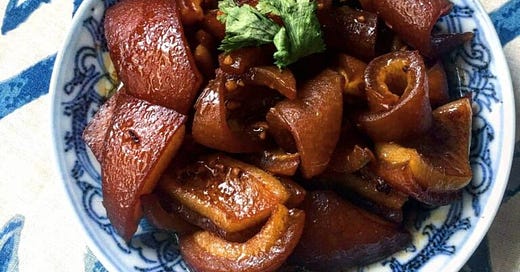Today’s recipe comes from Krisada Virabhak, a young Singaporean of Thai-Peranakan descent who enjoys sharing about Peranakan culture, particularly about heritage food and traditional rituals.
In Singapore, traditional food functions not solely as a means of sustenance. They are also believed to be a bridge to the spirit world. Peranakans belong to the Hokkien ancestry, and traditionally subscribe to Chinese schools of thought such as Taoism, Confucianism and Buddhism. There is a strong emphasis on being respectful towards elders, and that respect extends to the dead.
In the past, many Peranakan families have an ancestral hall (thia abu) in their homes, dedicated to the ancestors of the family. The matriarch of the family, aided by the other Nonyas, would be in charge of ensuring that the altars were properly attended to. One part of her responsibilities would be to oversee the preparation of traditional food and drinks to be placed on the altar.
Traditionally, there would be as many as 12 dishes. Many of these would feature various parts of a pig, as old Hokkien customs dictate the utilization of the whole hog. Dishes include kuah perot babi (pig stomach soup), babi pongteh (stewed pork belly), hati babi bungkus (pig liver and caul fat) and sarang burong (pig skin) cooked in taucheo).
This practice is now uncommon, as many Peranakans have converted to Christianity and ancestral worship has been simplified for the modern age. While many dishes such as hati babi bungkus and babi pongteh are relatively well-known, thanks to the resurgence of Peranakan cuisine, others such as sarang burong have almost completely vanished.
Very grateful that Krisada is willing to share this lost recipe with us. Here’s more about the dish in his own words.
Krisada Virabhak’s Sarang Burong
“In the olden days, where many Peranakans practised ancestral worship, as many as twelve dishes were prepared to honour the dead. These elaborate rituals would be held at least five times a year- for Chinese New Year, Cheng Beng, Dumpling Festival, Lunar Seventh Month and Winter Solstice, not forgetting the death anniversaries of ancestors.
Ancient traditions also called for a whole pig to be offered. Different parts of a whole pig would be cooked in dishes. Before the invention of refrigerators, the pork seller would deliver the pork parts to the household, as early as 4am. The womenfolk would then start the preparation of food for prayers to begin in the late morning.
Some of the pork dishes included Tee Hee Char Rebong (Pig Lung slices with Bamboo Shoots in Taucheo sauce) or this dish, known as Sarang Burong. While it literally means Birds’ Nest, it is actually pig’s skin cooked in taucheo gravy. It probably earned its name from the shape of the cooked pig skin. When cooked, the pig skin pieces curl up, resembling dried birds’ nest sold in Chinese medical halls.
This dish is rarely found in homes because ancestral worship is simplified or not carried out anymore. For health reasons, my Mama stopped cooking these dishes but to me, it’s actually a good source of collagen!” – Krisada
2 rectangles of pig skin, 150g or 1 pack from NTUC
1 – 1 1/2 tablespoons salt
3-4 tablespoons oil
1 teaspoon minced garlic
1 teaspoon minced taucheo
1-2 slices of old ginger, without skin
1/2 tablespoon dark soy sauce
One small bowl of water
Rub the salt onto the pork skin, scrubbing until the surface of the skin is shiny. Rinse off excess salt from the pork skin and cut into diamond shapes with a pair of sharp scissors or a knife. Heat up the pot with the oil. When the oil begins to shimmer, add the garlic. When the garlic darkens slightly, add the taucheo and ginger and saute till fragrant. If the mixture is too thick, add in small amounts of water to prevent burning.
Add in the pig skin and dark soy sauce. Stir-fry until the pig skin starts to curl. Add half a bowl of water to simmer the pork skin until it is soft. If needed, add the other half later on to continue simmering the pig skin. Season with sugar and salt to taste. The dish should taste more savoury than sweet.
Garnish with coriander if desired. Serve with steamed rice.




